350 Colorado’s Public Lands Committee hosted an online screening of the new film PUBLIC TRUST, which was available to our community in August. Public Trust explored how our public lands are facing unprecedented threats from extractive industries and the politicians in their pockets. The film investigated how we arrived at this precarious moment through the examination of three beloved public lands that are particularly at risk—a national monument in the Utah desert, a mine in the Boundary Waters and oil drilling in the Arctic National Wildlife Refuge—and makes a case for their much deserved protection. If you missed the film showing, explore this website to get caught up. Thanks to 350 CO intern Katie Orton for today’s post.
The fight to stop greedy politicians and big industry money from selling off our publicly owned lands has lasted for generations: it’s hard to learn the entire history without getting sucked in to past scandals, heartbreaks, and political losses. But our government is willing and able to destroy some of the last functioning ecosystems in our country to make a profit, and if we don’t know what we are losing then we won’t care to protect them.
Colorado’s public lands are our most valuable resources. So many of our state’s defining qualities—our diverse landscapes, our ski slopes and hiking trails and climbing crags, our natural and cultural history—continue to exist in large part thanks to our robust land conservation laws. Even more importantly, our public lands also provide invaluable ecosystem services; these areas have critical functions in regulating our climate and maintaining the health of our environment at large.
But our public lands are in danger. Not only are they especially vulnerable to the effects of climate change, they are also being sold off and exploited to produce the dirty energy that is fueling their destruction. Over the past decade, 40 percent of US coal and a quarter of our oil and natural gas were produced on public lands. Under the current administration, sales and leases of public land have accelerated as the Interior Department shifts its priorities from conservation to energy development.
Beyond just National Parks and Monuments, the American people have rights to roughly 640 million acres of land in the US, most of which is in the West. The Federal Government maintains it for humans to enjoy, ranchers to make livelihood and raise livestock, and for wildlife to survive in their natural habitat. Private, profit-minded companies can take over by simply calling to transfer public land to state control — something that sounds harmless enough. But once the land belongs to the state instead of the federal government, it would be too costly to maintain, requiring them to hand it off to the highest bidder.
Once our lands have been sold, they’re gone forever. What was thought to be untouchable land is no longer safe. In Alaska, the area of the Arctic National Wildlife Refuge that has been opened for oil drilling is the calving grounds of the Porcupine Caribou. The Gwitch’in people have lived with the Caribou for generations and rely on the herds for survival, but despite their incredible resistance, the Trump administration has finalized plans to auction the precious land for drilling leases.
In Utah, the Bears Ears Inter-Tribal Coalition was formed out of necessity to protect and defend sacred land. Though Bears Ears was designated a National Monument in 2016, it has been reduced to only 15% of its intended size, leaving 1.3 million acres of culturally historic land completely unprotected.
Here in Colorado, North Fork Valley has been at stake for years, with oil and gas attempting to claim the region from farmers and put vital watersheds at risk. The area is home to a federally recognized wine region, organic farms and orchards, bald eagles and Canada lynx, and beautiful hiking. Despite ongoing concerns, the Bureau of Land Management is dedicated to opening over 870,000 acres to oil and gas leasing.
These cases are only the tip of the iceberg. There is so much more to learn, and plenty of work to do to keep our land, animals, and history, protected.
Here’s how you can take action:
- Send a letter to the Colorado State Land Board now, urging them to take leadership toward Colorado’s clean energy future. It is time to stop jeopardizing the health and safety of the environment and our communities, and to properly protect Colorado’s public lands for generations to come.
- Vote! It’s up to us to put representatives into office who will protect, not sell, our public lands. In the meantime, we must urge our senators to vote in our best interest on the current conservation bills: Support the CO Wilderness Act that will protect CO Public Lands and Support the CORE act
- Educate yourself and spread the word! Go to https://www.conservationlands.org/time_to_choose, https://www.outdooralliance.org, or https://www.patagonia.com/actionworks/campaigns/public-lands-waters-threat to learn more.
- Join the 350 CO Public Lands Committee, and receive ongoing action alerts. 350 Colorado has a Public Lands Committee which meets regularly with the goal of protecting our local public lands from the extractive oil and gas industry, and has been focused on calling on the Colorado State Land Board.
Katie Orton is a 350 CO Intern who’s always ready to learn more about climate change and the ways we – often unknowingly – are letting our planet slip away. She lives in a tiny house she built with her partner in Longmont, CO. She believes in the power of voting and staying optimistic… most of the time.

Photo courtesy of Outdoor Alliance
